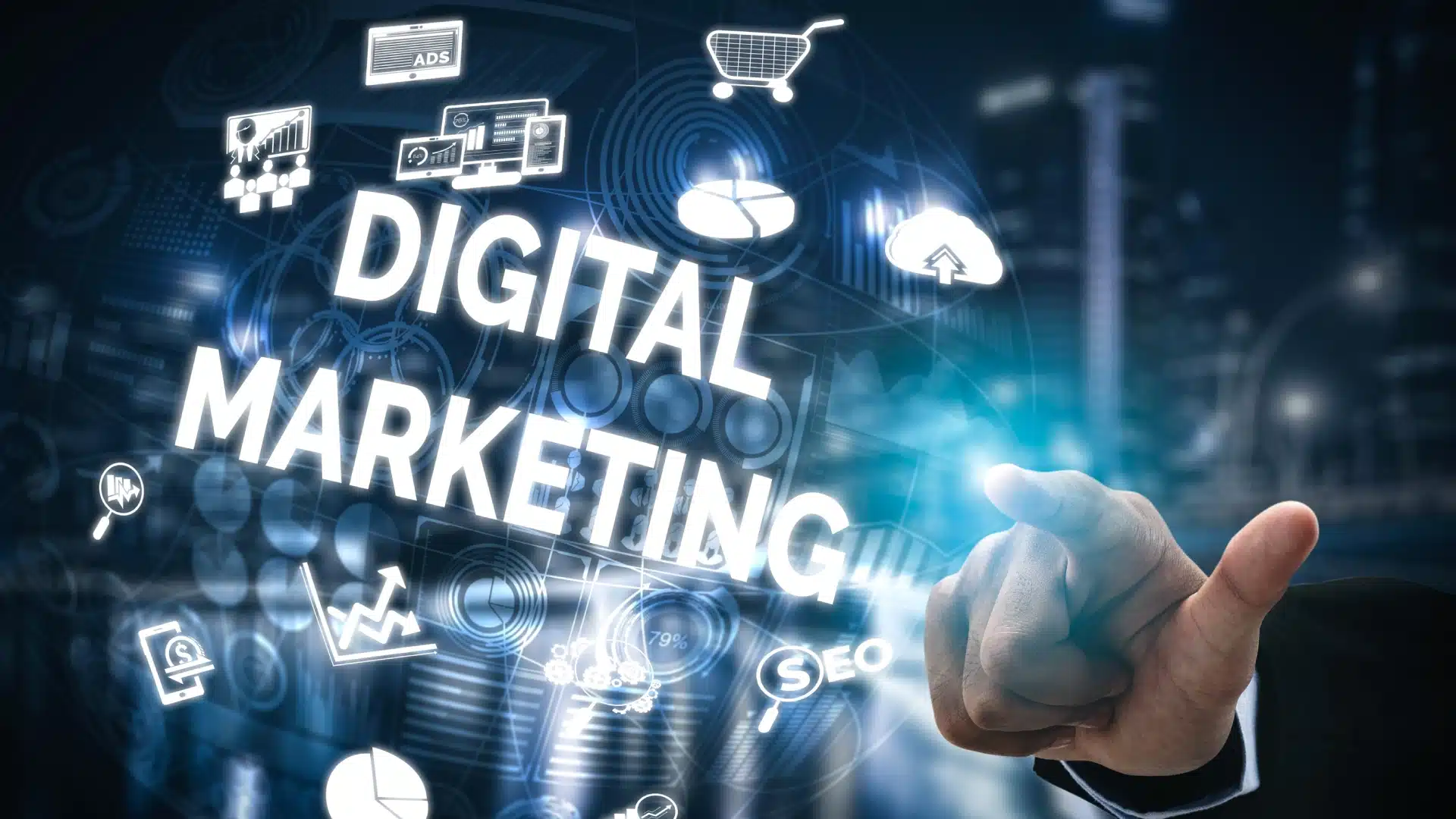In 2024, digital marketing continues to evolve rapidly, and staying ahead of the curve is crucial for businesses aiming to thrive in the competitive online landscape. Here are the key digital marketing trends that are set to dominate the digital marketing space this year:
Top Digital Marketing Trends
1. Artificial Intelligence and Machine Learning

AI and ML are transforming how marketers gather and analyze data, create content, and deliver personalized experiences. Tools powered by AI can predict consumer behavior, optimize ad targeting, and automate customer interactions, making marketing efforts more efficient and effective.
Digital Marketing Trends are being revolutionized by AI-powered tools, which enable data-driven decision-making, personalized customer experiences, and targeted advertising campaigns.
2. Personalization
Personalization is no longer just a nice-to-have; it’s an expectation. Advanced data analytics and AI allow for hyper-personalized marketing, tailoring content, offers, and communication to individual preferences and behaviors. This increases engagement, loyalty, and conversion rates.
3. Video Content Dominance
Video continues to be a powerful medium for storytelling and engagement. With platforms like TikTok, Instagram Reels, and YouTube Shorts gaining popularity, short-form video content is becoming essential for capturing audience attention. Live streaming and interactive videos are also on the rise, providing real-time engagement opportunities.
4. Voice Search Optimization

As smart speakers and voice-activated devices become more prevalent, optimizing content for voice search is critical. This involves using natural language keywords and answering common questions directly and concisely to improve visibility in voice search results.
5. Influencer Collaboration
Digital Marketing Trends involve strategic Influencer Collaboration, partnering with influencers across various niches to amplify brand messages and reach highly engaged audiences. Influencer marketing remains a key strategy, but it’s evolving. Micro and nano-influencers, who have smaller but highly engaged audiences, are becoming more valuable for brands. Authenticity and genuine connections are prioritized over follower counts.
6. Social Commerce
The integration of e-commerce and social media platforms is streamlining the shopping experience. Features like shoppable posts, in-app checkout, and live shopping events on platforms like Instagram, Facebook, and TikTok are making it easier for consumers to purchase directly from social media.
7. Privacy and Data Protection
With increasing concerns over privacy and data security, marketers need to be transparent about data collection and usage. Complying with regulations like GDPR and CCPA, and prioritizing consumer trust, will be crucial. First-party data collection strategies are becoming more important as third-party cookies phase out.
8. Augmented Reality (AR) for Digital Marketing Trends

AR is enhancing the customer experience by allowing users to interact with products virtually. From trying on clothes to visualizing furniture in their homes, AR provides an immersive shopping experience that can drive engagement and sales.
9. Content Marketing Evolution
High-quality, relevant content remains king. However, the focus is shifting towards more interactive and immersive content formats, such as interactive infographics, quizzes, and virtual reality experiences, which engage users more deeply.
10. Sustainability Marketing
Consumers are increasingly valuing sustainability. Brands that communicate their commitment to environmental and social responsibility through their marketing efforts are likely to build stronger connections with their audiences.
11. Interactive and Immersive Experiences
Engaging customers through interactive content such as polls, quizzes, and games is becoming more popular. Immersive experiences using virtual reality (VR) and augmented reality (AR) can deepen user engagement and create memorable brand interactions.
12. Omnichannel Marketing
Consumers expect a seamless experience across multiple channels. Omnichannel marketing ensures that a brand’s message and customer experience are consistent across all touchpoints, from social media to physical stores. This holistic approach can significantly enhance customer satisfaction and loyalty.
13. User-Generated Content (UGC)
UGC, such as reviews, testimonials, and social media posts from customers, continues to be a powerful marketing tool. It builds trust and authenticity, encouraging potential customers to engage with the brand. Encouraging and showcasing UGC can enhance brand credibility and community engagement.
14. Chatbots and Conversational Marketing

Digital Marketing Trends see widespread Chatbot Adoption for customer service and engagement, offering personalized assistance and recommendations 24/7 across various digital channels. Chatbots powered by AI are becoming more sophisticated. Conversational marketing, which involves real-time, one-on-one connections with customers, helps in building stronger relationships and improving customer satisfaction.
15. Programmatic Advertising for Digital Marketing Trends
Programmatic advertising uses automated technology to buy and sell digital advertising space. This method is becoming more advanced, allowing for more precise targeting and real-time bidding. Programmatic ads can optimize ad spending and deliver more relevant ads to the right audience.
16. Interactive Email Marketing
Email marketing is evolving with interactive elements like embedded videos, carousels, and gamification. These features enhance user engagement, making emails more dynamic and engaging, thus improving click-through rates and conversions.
Digital Marketing Trends utilize Email Marketing Automation to deliver personalized and targeted email campaigns, nurturing leads and driving conversions through automated workflows and segmentation.
17. Customer Experience (CX) Focus
A great customer experience is becoming a key differentiator. Brands are investing in CX strategies to provide seamless and delightful interactions across all touchpoints, from initial engagement to post-purchase support. Enhanced CX leads to higher customer satisfaction and loyalty.
18. Blockchain Technology
Blockchain is being explored for its potential in digital marketing, particularly in enhancing transparency and security in advertising. It can help combat ad fraud, verify the authenticity of products, and protect consumer data, thereby building trust with customers.
19. Visual and Voice Search

Beyond text, visual and voice search are gaining traction. Optimizing for these search types involves using high-quality images with proper tags for visual search and focusing on conversational keywords for voice search, aligning content with how people naturally speak.
20. 5G Technology for Digital Marketing Trends
The rollout of 5G technology will revolutionize mobile marketing. Faster internet speeds and improved connectivity will enhance the delivery of rich media content, AR/VR experiences, and real-time interactions, providing a more engaging user experience.
21. Social Media Stories
Brief content, such as Instagram and Facebook Stories, continues to grow in popularity. This format allows brands to share timely, authentic content that encourages immediate engagement. Utilizing Stories for behind-the-scenes looks, limited-time offers, and interactive polls can drive higher engagement.
22. Interactive Web Design
Interactive web design elements, such as animations, scroll-triggered effects, and 3D visuals, can enhance user experience and engagement on websites. These dynamic features can make browsing more enjoyable and memorable, leading to increased time spent on the site and higher conversion rates.
23. Podcast Marketing
Podcasts are becoming a valuable marketing channel for reaching niche audiences. Brands are increasingly sponsoring podcasts or creating their own to share expertise, stories, and engage with listeners on a deeper level. The intimate nature of podcasts can build strong brand connections.
24. Virtual Events and Webinars
Virtual events and webinars have become an integral part of digital marketing strategies. They offer a cost-effective way to reach a global audience, provide valuable content, and foster direct interaction with attendees. Leveraging these platforms can enhance brand authority and lead generation.
25. Data-Driven Marketing
Data-driven marketing involves making strategic decisions based on data analysis and interpretation. Utilizing data analytics tools, businesses can gain insights into customer behavior, preferences, and trends, allowing for more effective targeting and personalization of marketing efforts.
26. Hyper-Local Targeting
Hyper-local targeting allows marketers to reach audiences based on their precise geographic location. Leveraging location data, businesses can deliver highly relevant ads and promotions to consumers in specific neighborhoods or even within a certain radius of their physical stores, maximizing the impact of their marketing efforts.
27. Micro-Moments Marketing
Micro-moments refer to brief, intent-driven interactions that consumers have with brands throughout their daily lives, such as searching for information, making a purchase decision, or seeking assistance. By understanding and capitalizing on these micro-moments, marketers can deliver timely and relevant messages that meet the immediate needs of their target audience.
28. Predictive Analytics
Predictive analytics utilizes historical data, statistical algorithms, and machine learning techniques to forecast future trends and behaviors. By analyzing patterns and identifying correlations within data sets, marketers can make informed predictions about consumer preferences, purchase intent, and market trends, allowing them to tailor their marketing strategies for maximum effectiveness.
29. Emotional Marketing
Emotional marketing focuses on tapping into consumers’ emotions to create meaningful connections with brands. By evoking feelings of joy, nostalgia, empathy, or excitement, marketers can elicit strong emotional responses from their audience, driving engagement, brand loyalty, and advocacy.
30. Local SEO Optimization
Digital Marketing Trends focus on Local SEO Optimization to enhance visibility in local search results, including optimizing Google My Business listings and obtaining positive reviews and ratings.
31. Brand Purpose and Values
Consumers are increasingly drawn to brands that demonstrate a clear sense of purpose and align with their values. By articulating their brand purpose and championing social and environmental causes, businesses can differentiate themselves from competitors, build deeper connections with consumers, and foster brand loyalty and advocacy.
32. Inclusive Marketing
Inclusive marketing involves creating campaigns and content that reflect the diversity of the target audience and celebrate different backgrounds, cultures, identities, and perspectives. By embracing inclusivity and representation, marketers can resonate with a broader range of consumers, foster inclusivity, and build a more inclusive brand image.
33. Gamification
Gamification involves incorporating game-like elements, such as challenges, rewards, and leaderboards, into marketing campaigns to engage and motivate consumers. By adding an element of fun and competition, marketers can increase user engagement, drive participation, and enhance brand loyalty and retention.
34. Subscription-Based Models
Subscription-based models are becoming increasingly popular across various industries, from streaming services and software applications to meal delivery and grooming products. By offering subscription-based services, businesses can generate recurring revenue, foster long-term customer relationships, and provide ongoing value and convenience to consumers.
35. Brand Communities
Brand communities are online or offline communities of like-minded consumers who share a common interest, passion, or affinity for a particular brand. By nurturing and engaging with brand communities, businesses can create a sense of belonging and loyalty among their customers, facilitate peer-to-peer support and advocacy, and gain valuable insights and feedback.
36. Mobile-First Marketing
With the continued proliferation of smartphones and mobile devices, marketers must prioritize mobile-first strategies to reach and engage consumers effectively. By optimizing their websites, content, and advertising campaigns for mobile users, businesses can ensure seamless and intuitive experiences across all devices, driving engagement, conversions, and customer satisfaction.
Digital Marketing Trends prioritize Mobile-First Marketing, ensuring that websites and content are optimized for mobile devices to provide seamless user experiences and improve search rankings.
37. Brand Authenticity
In an era of skepticism and distrust, authenticity is paramount for brands seeking to build meaningful connections with consumers. By being transparent, genuine, and consistent in their messaging and actions, businesses can earn the trust and loyalty of their audience, differentiate themselves from competitors, and cultivate a strong and authentic brand identity.
38. Niche Marketing
Niche marketing involves targeting specific segments of the market with tailored products, services, and messaging that address their unique needs, preferences, and pain points. By focusing on niche audiences, businesses can establish themselves as experts in their respective fields, attract highly engaged and loyal customers, and achieve greater success and profitability.
39. Employee Advocacy
Employee advocacy involves empowering and encouraging employees to promote and endorse their employer’s brand, products, and services on social media and other channels. By harnessing the collective reach and influence of their workforce, businesses can amplify their marketing efforts, enhance brand visibility and credibility, and foster a culture of brand advocacy and pride among employees.
40. Continuous Learning and Adaptation
In a rapidly evolving digital landscape, marketers must embrace a mindset of continuous learning and adaptation to stay ahead of the curve. By staying informed about emerging trends, technologies, and best practices, experimenting with new strategies and tactics, and learning from both successes and failures, marketers can remain agile, innovative, and successful in driving business growth and achieving their marketing objectives.
By understanding and implementing these trends, businesses can effectively navigate the digital marketing landscape in 2024, ensuring they remain competitive and relevant in an ever-changing environment.






One thought on “Surfing the Future: Navigating 2024’s Digital Marketing Trends”